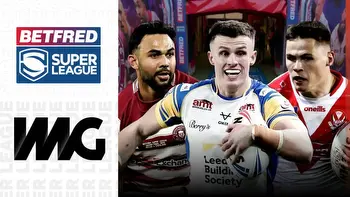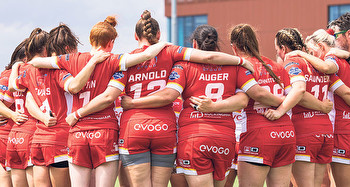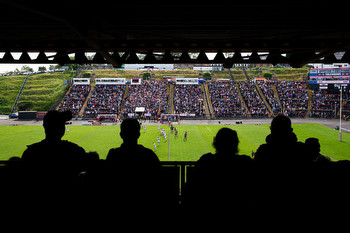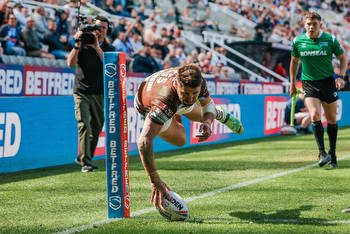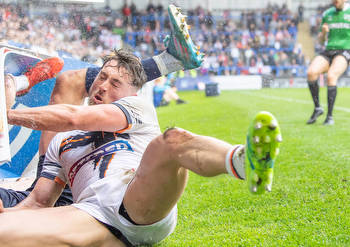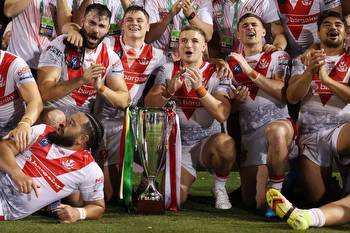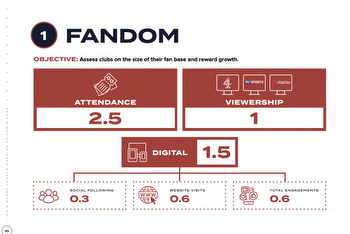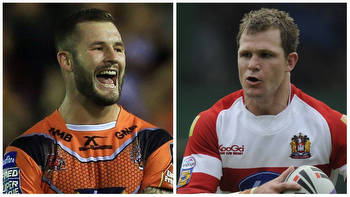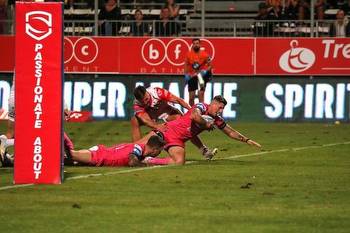Our 24 hopes for Rugby League in 2024
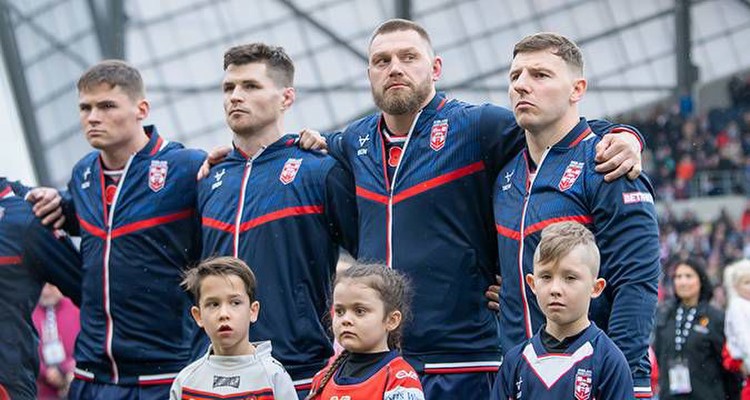
ANOTHER pivotal year is in store for Rugby League, with a new grading system about to come into force, a potentially game-changing TV deal beginning, and seismic rule changes being introduced.
There are uncertainties wherever you look, including the future structure of the professional leagues and where the next World Cup will be played, although the top action on the pitch will no doubt offer some familiarity.
Here are 24 hopes for 2024, covering the major on- and off-field narratives to keep an eye on.
Viewing figures boom
Every Super League match will be broadcast live in 2024 by Sky Sports, meaning the competition should receive greater exposure than ever before.
The fact that matches will clash despite this move isn’t promising, but Sky have the chance to bring a record following to Rugby League, and a significant growth in TV audiences is vital to growing the value of its top competition.
Free-to-air coverage helped put more eyeballs in front of the game in the past two seasons and, if another deal can be struck, Super League can expect its best-ever viewing figures.
Take TV opportunity
With the game being given less money than under the previous TV deal for the privilege of every match being shown live, it is vital that clubs – and the competition as a whole – make the absolute most of the opportunity afforded to them.
Clubs should be in the spotlight more often and must use this to grow their profile and boost everything from sponsorship to their digital following.
The same can be said for Super League overall, which should look better than ever thanks to Sky’s increased commitment and must accordingly sell itself as a high-end sporting product.
Amateurs adapt to tackle rules
Amateur players are getting ready for a seismic rule change which will see the legal tackle height reduced, from below the neck to below the armpit.
With the professional game then set to follow in 2025, it is crucial that the rule does not change the sport completely – as many fans worry it will, beyond repair – and spoil it as a spectacle.
It will undoubtedly take some getting used to, but is being done for the right reasons, to ensure the safety of players and a future for the sport. The adaptation at grassroots level will reveal much about the game’s direction.
Fewer serious head injuries
At professional level, there is still another season before new tackle-height rules come into force, but other changes are being made immediately in Super League.
The number of failed head-injury assessments last season was concerning and among the changes for 2024 are the mandatory use of instrumented mouthguards – where head acceleration load is monitored live by club medics – and the introduction of independent concussion spotters on a trial basis.
It will mean more players being withdrawn from matches because of a head knock, but hopefully fewer serious – and long-term damaging – head injuries being inflicted.
No grading drama
The full introduction of the club-grading system at the end of 2024 makes this a huge year for the game.
Most clubs are just about on board with the process and willing to jump through the various hoops put in front of them, but how it all unfolds in practice remains to be seen.
Thank goodness there was a trial run last year, not least as a row over an incorrect submission from Castleford rumbled on for weeks. Anything similar next time would be a farcical start to a new era that is yet to win the hearts of most fans.
The big hope behind the club-grading system was that it would both encourage clubs to seek out fresh investment, and make clubs more attractive to potential investors.
Since its introduction, Wakefield and Toulouse have come under new ownership with big ambitions to become ‘Grade A’ and compete at the top end of Super League.
Castleford also recently secured much-needed investment and other clubs – especially Salford – are crying out for the same, especially lower-league sides who risk being left behind for good under the new system without the sort of investment seen at Oldham under new owners.
Household names emerge
Rugby League’s lack of any recognisable, household name in the UK is both a symptom of its low profile and a cause of it, and breaking that cycle has appeared to be beyond the sport’s leaders.
But it would be a huge shot in the arm if a star could cut through, such as Jack Welsby, who has the obvious potential to do just that after signing a new contract at St Helens.
Or perhaps the return of one its biggest names at present, Sam Burgess, will do the trick, and his fortunes as Warrington coach will get more people talking about the game.
World Cup to be excited about
The next World Cup has not only been delayed until 2026, but it is still unknown where the event will even be held.
Whichever country or coalition in the southern hemisphere picks up the baton, they will hopefully plan a World Cup with some ambition that can get supporters – and players – excited.
The reduction in men’s teams from 16 to ten, and scrapping of initial plans to expand the women’s and wheelchair tournaments, mean it is already on the back foot, and the limited preparation time will make it an even more difficult task, but a strong World Cup is essential for the sport.
Top test for England
As it stands, England’s men have no confirmed fixtures in 2024, though they hope to persuade Samoa to tour and are likely to play France in mid-season too.
Regardless of whether Samoa come, what England desperately needs is top international action, especially after a Tonga series that wasn’t as competitive as perhaps we anticipated.
If Samoa come, let’s hope they perform better than in last year’s Pacific Championships and can develop an attractive rivalry. If they don’t, England need to be facing the world’s best nations at the end of the year down under.
Unpredictable international scene
International Rugby League’s downfall has often been its lack of competitiveness, but last year all three number-one ranked nations and world champions, in the men’s, women’s and wheelchair games, were beaten.
The Kangaroos’ record Test defeat to the Kiwis and the Jillaroos’ first loss in seven years, against the Kiwi Ferns, are hopefully signs of things to come.
Australia’s hegemony, and the subsequent predictability of big matches and tournaments, does little for the status of the international game there or in any other country.
Another underdog story
Leigh winning the Challenge Cup was one of the stories of 2023, with the lack of a traditional giant in their final against Hull KR adding extra intrigue to the Wembley showpiece.
With the number of genuine contenders for silverware, particularly the Super League title, so low, another underdog story would be most welcome for the sport.
Any league winner bar the usual three would be historic, while none of Hull KR, Salford and Huddersfield have won a major trophy since long before the summer era and should harbour hopes of following in Leigh’s footsteps.
Broncos buck expectations
London Broncos’ indicative grading means they are as good as damned before the Super League season has even begun.
It’s a unique and sad turn of events – albeit one that won’t be repeated – so the Broncos will aim to be in the top flight for a good time if not for a long time.
London are understandably not pushing the boat out financially, but nobody expected them to come through the Championship play-offs either. They may cause a shock or two – and hopefully give Rugby League in the capital a much-needed boost in the process.
Magic stays or goes
Magic Weekend has been one of the more successful Rugby League innovations in modern times and remains a popular event for many fans, yet its future was up in the air for most of last year.
After prevaricating on whether to ditch it, as proposed by IMG, or keep it, it has stayed on the calendar for 2024 but at a significantly smaller venue, Leeds’ Elland Road.
Already struggling to make their top ‘central events’ – Wembley, the Grand Final and England matches – add up financially, RL Commercial will surely take another hit and must make a firm call, one way or the other – go all in, or get rid.
Crowds keep going up
The average Super League attendance rose in 2023 by an impressive 900, up to 9,256 – the highest figure in eight years.
Pressure should now be on clubs – and strategic partner IMG, who have been working with them to improve their digital and commercial offering – to not rest on their laurels but keep growing those numbers year-on-year.
Of particular importance is for Super League to achieve more sell-outs – nothing makes the sport look more attractive than it being played in full stadiums and it leaves others wondering what they’re missing out on.
Lower-league coverage
While Super League prepares for the full broadcast experience, the Championship faces being left out altogether if no deal is reached to keep the second tier on screens.
Premier/Viaplay Sports provided good coverage of the competition and, following a recent takeover to keep the channel on air, could yet continue to do so – hopefully they will, because there are few other takers.
Regardless, the lower leagues as a whole could do with better coverage – trying to find even highlights of decent quality for matches can be an impossible task. As good as League Express reports are, being able to watch the tries is nice too!
Championship retains meaning
This is the first Championship season since 2014 in which there is no promotion to play for, but that will hopefully not diminish a thrilling competition to watch.
On-field performance does still count for something under club grading, and the bonus points for competition wins are extra motivation for the likes of Wakefield, Toulouse, Featherstone and Bradford if the trophies themselves aren’t enough.
But the wonderful drama and jeopardy of last year’s play-offs, when London overcame the odds to reach Super League, will take some replacing.
New structure gives all clubs a chance
The professional structure could be set for another big change in 2025 as lower-league clubs reconsider the current format.
League One clubs, almost to a man, wanted a merged competition in time for this year, but Championship clubs were against the idea and the third tier remains as a further diminished, nine-team division for now.
Whatever structure emerges from the ongoing discussions, there must be an end to the current state of play, where League One is a financially unsustainable competition and clubs have little chance of prospering without getting straight out of it.
1895 Cup fully bought into
The 1895 Cup has been expanded for 2024, returning to a full competition with (almost) every lower-league club involved for the first time since its inaugural year in 2019.
This is the chance for the competition to have a space and identity of its own, and every club should buy into the rewards that it brings – not just glory but a chance to play at Wembley.
The scheduling of matches, up to and including the quarter-finals before the league campaigns begin will hopefully not see it approached by teams as akin to a pre-season tournament.
Marquee venue for Women’s Grand Final
Last year will go down in history as the first to have the Women’s Challenge Cup final played at Wembley, as St Helens beat Leeds at the country’s biggest stadium.
That sort of prestige was not given to the Women’s Super League Grand Final, which was somewhat unsatisfactorily played at the home ground of one of the participating clubs, York.
The biggest women’s stars are becoming increasingly at home on the biggest stages and should have a better, neutral venue – perhaps even making a home alongside the men’s equivalent in an Old Trafford double-header.
Competitive WSL at both ends
The Women’s Super League has a new look in 2024, with an eight-team competition replacing the previous two divisions of six.
One of the pitfalls of the competition in recent years has been the huge gap in quality between clubs, and particularly between the ‘big three’ of York, Leeds and St Helens and the rest.
While that disparity won’t change overnight, the addition of other entrants – Barrow and Featherstone have come up – should at least mean competitive matches for all sides, at both ends of the table, and an overall rise in standards as a result.
Wheelchair following
England’s home clash with France at the end of 2023 was a reminder of the continuing popularity of the wheelchair game at the top level.
But it’s a success that is only gradually filtering down to the club game, despite many truly fantastic Wheelchair Super League clashes taking place, including Wigan’s Grand Final win over Leeds. Attendances are creeping up but can often be counted in the dozens.
With its domestic competition very much on the fringes, the wheelchair game still appears to be ‘Rugby League’s best-kept secret’ even after the World Cup boom in interest.
English talent thrives in NRL
For as long as the NRL is streets ahead of Super League financially and on the field, it is inevitable that many of the best English players will seek a career down under.
The likes of Dom Young and Herbie Farnworth excelled in the competition last year, and there are several talented young players who have made their way to Australia for this season.
Fresh from Grand Final glory with Wigan, Morgan Smithies and Kai Pearce-Paul have joined Canberra and Newcastle respectively, while the less experienced Will Pryce (Newcastle) and Lewis Murphy (Sydney Roosters) will hope to make an impact too.
Vegas gamble delivers pay-out
Rugby League’s efforts at expansion have often been half-hearted, underfunded and poorly-executed – but when it’s the NRL involved, things are done differently.
The game’s biggest league has gone all in with Las Vegas, taking a season-opening double-header to its Allegiant Stadium in March for what it hopes will become an annual trip.
The greatest rewards are likely to be seen only in the long-term but if it can bring not only a financial reward to the NRL, but spark a greater presence for the sport in the USA, it will have been a gamble worth taking.
Wigan win WCC
We prayed for English success in this feature last year, and St Helens delivered with a stunning victory over Penrith in Australia, so let’s see if lightning strikes twice!
Wigan are going into battle for Super League this time and do so with a team that ended 2023 on a delicious hot streak and with home advantage at the DW Stadium next month.
Again the opposition is provided by a Panthers side approaching legendary status as the NRL champions three seasons running – but they are yet to win a World Club Challenge in three attempts.
The above content is available in the regular weekly edition of League Express, on newsstands every Monday in the UK and as a digital download..

